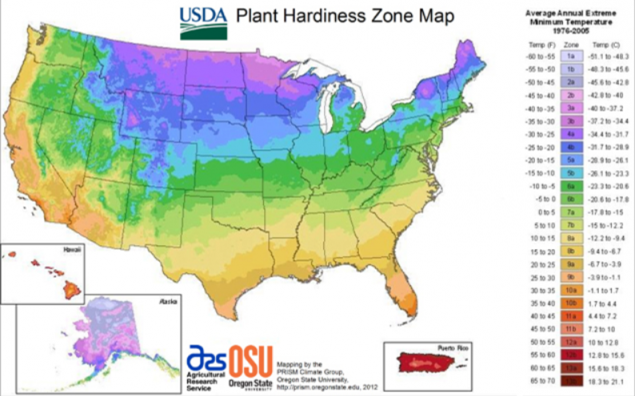Buying plant seeds is different from buying plants that are already grown in flats — and if you don’t plan accordingly, your yard or garden is likely to look a little bare.
So whenever spring is around the corner, you’ll need to start preparing for spring planting and figure out which plants you want to grow. It takes a little more time and patience to grow your own but the results are worth the effort.
With that in mind, here’s a quick rundown of everything you’ll need to consider for a spring planting — as well as a few plants that grow exceptionally well in the springtime.
Start By Considering Your Location
All areas of the country don’t transition to warmer weather at the same time. Although the entire country welcomes the start of spring every year in March, not everyone experiences spring weather at the same time.
That’s why the USDA provided us with a Hardiness Zone Map to help determine the best time to plant early spring flowers, grasses, and other plants in your location. Finding your “zone” will ensure you choose spring plants that will grow well year-round in your area.

Once you find your zone, you’ll need to pick your seeds and then plant them.
To do that, you’ll have to decide which types of spring plants you want and the purpose they will serve. Some spring flowers work best in confined areas while others are great for covering large bare areas.
There are also some spring vegetables that thrive when planted during the spring. Others need to wait until the temperatures are warmer and the risk of frost is no longer a worry.
But one of the best ways to choose seeds is to just go with the same types of plants that people turn to year after year — which is where this post can help. The list below represent plants from several different categories that are easy to plant and they produce predictable outcomes.
Top Spring Flowers
- Regional Wildflower Mixes – Choose a regional wildflower mixture based on your region and add a splash of color to your landscaping. They contain a mixture of perennials, which bloom for one season and come back every year, and annuals, which must be replanted each year.
- Shasta Daisy (Chrysanthemum maximum) – This wildflower is one of the best plants to grow in spring! you can plant in early spring to see blooms from May to August.
- Maximilian Sunflower – This forb (broadleaf plant with beautiful blooms) produces showy, yellow ray flowers from midsummer to fall with an optimal seeding time from late fall until early spring.
Top Spring Vegetables
- Lettuce – One of the easiest spring vegetables to plant, you can sow lettuce seeds as early as eight weeks before the last spring frost.
- Snow Peas – Snow peas can be planted as soon as the ground loosens enough to work it during early spring.
- Radishes– You can plant radishes in early spring or late fall, and they’re ready to harvest in just a few weeks.
- Cauliflower – Save money and get a better flavor when you plant your own cauliflower seeds early in the spring.
- Broccoli – Like cauliflower, you can plant your broccoli seeds up to six weeks before the last frost, but they may take longer than other vegetables to produce quality mature heads.
Top Spring Grasses
- Colonial Bentgrass – This lush grass is often used as turf and you can plant it during any part of the spring, summer, or fall.
- Arizona Cottontop – This grass is often used as an ornamental grass for its cotton-like seed heads that you can plant during spring or fall.
- Weeping Lovegrass – An attractive grass in spite of its sad name, it can be planted in late spring to early summer.
- Zoysia Grass – Zoysia is a warm weather turf grass that withstands heavier foot traffic and does well in a variety of soils.
- Buffalo Grass – A warm weather grass that creates one of the lowest maintenance lawns for your home.
Other Plants for Spring Planting
You might need a little more advance planning when choosing shrubs and trees for your landscaping, as most require climates that are similar to those to which they are indigenous.
If you decide to go big though, choosing the right plants for your location depends on the amount of moisture, sun exposure, and temperatures year round.
- White-Thorn Acacia – This small, thorny tree spreads from 2 to 10 feet tall and grows small orange-yellow flowers that attract birds and small mammals.
- False Mesquite or Fairy-Duster – This low-growing shrub produces attractive purple flowers during the spring that attract upland game birds and deer.
- Desert Willow – The small-to-medium sized tree reaches heights of 20 to 30 feet and produces beautiful pink to lavender flowers that bloom from April to September.
- Creeping Oregon Grape – The low evergreen shrub produces yellow blooms during the spring.
Conclusion
Growing your plants from seeds takes a little more effort than buying them off flats in the stores. But it also gives you more choices in the types and variety of plants that will serve your purpose. It also gives you a great sense of satisfaction for achieving a job well done!
A successful spring planting is easy when you start with a good plan, and choosing the right spring plants is more than using those with the prettiest blooms.
Some plants thrive in wet areas while others do well during droughts.
Some seeds grow best when you plant them during late spring.
And others thrive when you plant them during any season other than winter.
Don’t take shortcuts. Find the seeds that work best for your zone (and your yard), and then plant on time this season!